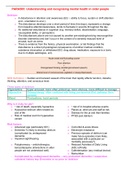PARA505: Understanding and recognising mental health in older people
Delirium:
o A disturbance in attention and awareness (EG: ability to focus, sustain or shift attention
and orientation to envr.).
o The disturbance develops over a short period of time (hrs-days), represents a change
from baseline attention/awareness, tends to fluctuate in severity throughout the day.
o An additional disturbance in cognition (e.g: memory deficit, disorientation, language,
visuospatial ability, or perception).
o The disturbances above are not caused by another pre-existing/evolving neurocognitive
disorder (dementia) and don’t occur in the context of a severely reduced level of
arousal, such as coma.
o There is evidence from the history, physical examination, or lab findings that the
disturbance is a direct physiological consequence of another medical condition,
substance intoxication or withdrawal (EG: drug abuse, medication, exposure to a toxin,
due to multiple aetiologies, ect).
Acute onset and fluctuating course
+
Poor attention
+
Disorganised thinking (rambling/incoherent speech)
or
Altered level of consciousness (agitated or sleepy/depressed)
NHS Definition = Sudden and transient assault of the brain that rapidly affects function, disturbs
thinking, attention, and conscious level.
Three types of delirium
Hyperactive hyper-aroused, more often picked up, more obvious, more difficult to manage
Hypoactive Drowsy/sleepy, often confused with being pre-terminal (EoL pathway, then
recover)
Mixed Fluctuations, lucid periods
Why is it risky for pts?
o risk of death, especially hypoactive o risk of in-hospital adverse events
o Hypoactive delirium often treated as o Places pt, other pts and staff at risk
end of life o Distress for the pt and their families
o Risk of medical cosh for hyperactive o PTSD post delirium.
variant
Risk factors:
o Advanced age (particularly 80+) o Comorbid & acute illness
o Dementia 7x likely to develop delirium o Electrolyte imbalance
(complicated by undiagnosed o Previous episode of delirium (can
dementia make future episodes more likely,
o Impaired sight/hearing associated with a particular co-
morbidity previously?).
o Polypharmacy – anticholinergics, o Reduced Activities of Daily Living
benzodiazepine (interactions in older (ADL’s)/Frailty
people are not understood well). o Catheterisation (any medical device)
o Malnutrition
- Complicated by undiagnosed dementia – very protracted dementia > suspicious
collateral history key (6-months or so prior to ‘delirium’
, What is happening in delirium?
o Infections
o Medications
o Low BP (not enough O2
getting to the brain)
o Underlying factors that can
make the brain more
susceptible to these changes
– the changes similar in
dementia & with
neurotransmitters.
Read other doc.
Tools for screening delirium:
The 4AT has 4 items:
1. Alertness
2. AMT4: Abbreviated Mental Test - 4.
3. Attention: Months of the Year Backwards
4. Acute change or fluctuating course
AMT – Abbreviated mental test
A score of 4/more represents delirium,
however, cannot be diagnosed without
clinical judgement.
Many pts are unable to produce meaningful
speech due to drowsiness/severe
inattention.
Design of the test enables pts to be scored
even if the pt cannot engage with the tester
& attempt the test, they are then rated
‘untestable’ and given a score.
Untestable status on both attention and
amt4 test scores 4, suggesting possible
delirium.
Item 1: altered level of alertness
If a pt is unable to speak due to
is >95% likelytotobebe
drowsiness/unable deliriumonin4AT,
assessed
the pt is then scored as having abnormal
alertness (Item 1), and a untestable result




